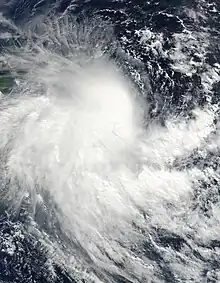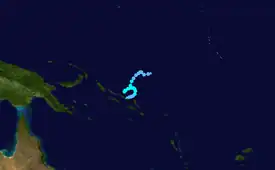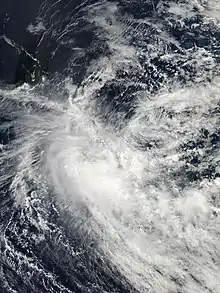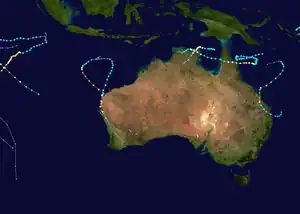Cyclone Raquel
Tropical Cyclone Raquel was the first tropical cyclone to exist within the South Pacific Ocean during the month of July on record. The system was first noted during June 28, 2015, while it was located to the northeast of Honiara in the Solomon Islands within the South Pacific basin. Over the next few days the system moved south-westwards towards the Solomon Islands, under the influence of a ridge of high pressure and gradually developed further. The system was subsequently named Raquel during June 30, as it moved into the Australian region and developed into a Category 1 tropical cyclone on the Australian tropical cyclone intensity scale. Strong vertical wind shear subsequently limited further development of the system, with atmospheric convection surrounding the system displaced to the west and south of the system. The system subsequently weakened into a tropical depression during July 2, after it had recurved and move eastwards into the South Pacific basin. During that day atmospheric convection surrounding the system improved, as it started to move towards the south-southwest and the Australian region. Raquel subsequently passed near or over several of the Solomon Islands between July 3–5, before it was last noted to the south-west of Guadalcanal during July 5, as it rapidly lost its tropical characteristics.
 Raquel prior to peak strength on June 30 | |
| Meteorological history | |
|---|---|
| Formed | June 28, 2015 |
| Dissipated | July 5, 2015 |
| Category 1 tropical cyclone | |
| 10-minute sustained (BOM) | |
| Highest winds | 65 km/h (40 mph) |
| Lowest pressure | 996 hPa (mbar); 29.41 inHg |
| Tropical storm | |
| 1-minute sustained (SSHWS/JTWC) | |
| Highest winds | 85 km/h (50 mph) |
| Lowest pressure | 989 hPa (mbar); 29.21 inHg |
| Overall effects | |
| Fatalities | 1 direct |
| Missing | 8 |
| Damage | Minimal |
| Areas affected | Solomon Islands |
| IBTrACS | |
Part of the 2014–15 South Pacific cyclone season and 2014–15 Australian region cyclone season | |
Raquel brought major flooding to the Solomon Islands where significant damage took place; including a large amount of agricultural damage and structural damage to hundreds of homes.
Meteorological history

Tropical storm (39–73 mph, 63–118 km/h)
Category 1 (74–95 mph, 119–153 km/h)
Category 2 (96–110 mph, 154–177 km/h)
Category 3 (111–129 mph, 178–208 km/h)
Category 4 (130–156 mph, 209–251 km/h)
Category 5 (≥157 mph, ≥252 km/h)
Unknown
During June 2015, a near record strength pulse in the Madden–Julian oscillation lead to a period of significant weather across the Western Pacific.[1] This significant weather included a major westerly wind burst during late June, which caused a set of twin tropical cyclones to develop.[2] The first tropical cyclone developed in the Northern Hemisphere during June 29, before it later developed into Typhoon Chan-hom.[2][3] The second tropical cyclone was first noted by the Fiji Meteorological Service (FMS) and the Australian Bureau of Meteorology (BoM) as Tropical Disturbance 17F and Tropical Low 24U during June 28, while it was located about 660 km (410 mi) to the northeast of Honiara in the Solomon Islands.[4][5] This system had a well-defined low level circulation centre which was located within an environment, that was marginally favourable for further development with low-moderate vertical wind shear offset by a poleward outflow.[5][6] The system subsequently moved south-westwards towards the Solomon Islands under the influence of a ridge of high pressure and gradually developed further and was classified as Tropical Depression 17F during the next day.[1][7]
The United States Joint Typhoon Warning Center (JTWC) subsequently issued a Tropical Cyclone Formation Alert during June 30, after the systems chances of becoming a significant tropical cyclone within 24 hours became high.[8] Later that day as the system approached 160°E and the border between the South Pacific Basin and the Australian Region, the JTWC initiated advisories on the system and designated it as Tropical Cyclone 25P.[9][10] 17F was subsequently named Raquel at 18:00 UTC (04:00 July 1, Australian Eastern Standard Time) by the BoM, after the system had developed into a Category 1 tropical cyclone on the Australian tropical cyclone intensity scale.[1][11][12] Throughout the following day, the BoM expected the system to intensify further and possibly become a Category 2 tropical cyclone, as it moved towards the Solomon Islands.[11][13] However, strong vertical wind shear limited development of the system, with atmospheric convection surrounding the system displaced to the west and south of the system.[14][15] As a result, Raquel had peaked as a Category 1 tropical cyclone, with 10-minute sustained wind speeds of 65 km/h (40 mph).[1] The system subsequently weakened into a tropical depression during July 2, after it had recurved and move eastwards into the South Pacific basin.[1][10] During that day atmospheric convection surrounding the system initially improved, as it started to move towards the south-southwest and the Australian region.[10][16] Raquel subsequently passed near or over several of the Solomon Islands between July 3–5, before it was last noted to the south-west of Guadalcanal during July 5, as it rapidly lost its tropical characteristics.[1][10][17]
Preparations and impact

Tropical Cyclone Raquel brought torrential rain, high seas and strong winds to the Solomon Islands throughout its lifetime, with widespread and extensive damage reported as a result.[18][19] As the system impacted the island nation, the Solomon Islands Meteorological Service issued various tropical disturbance and tropical cyclone watches and warnings.[20][21] These watches and warnings warned that near gale-force winds of 55 km/h (35 mph) would develop over most of the Solomon Islands, while coastal flooding, heavy rain and squally thunderstorms were also expected.[20][21] After Raquel had weakened into a tropical depression, residents were warned to still be prepared for flash floods and landslides with predictions of up to 100 mm (3.9 in) of rainfall in the Solomon Islands within a 24-hour period.[22] In response to Raquel, the Solomon Islands Ministry of Health and the World Health Organization called on the public to maintain safe hygiene practices, including hand washing and boiling water before drinking it.[22] As a result of the torrential rain, flash flooding was reported on several of the islands, which resulted in widespread damage in Malaita, Western, Choiseul and Isabel provinces.[19] In particular thousands of food gardens were extensively damaged or destroyed, including 40 thousand in Malaita Province alone.[18][23] One person was killed after being hit by a falling tree while 16 others were missing at sea.[19][23] The Gold Ridge Mine on the island of Guadalcanal was declared a disaster zone by the Solomon Islands Government during July 7, after rainfall associated with Raquel brought the tailings dam to within 20 cm (10 in) of full capacity.[24]
While Raquel was active, the Solomon Islands National Disaster Management Office activated their national disaster management arrangements.[25] It also prompted various emergency response clusters to activate their action plans, in case of a deployment to support the provinces impacted by the system.[25] Provincial assessment teams were subsequently deployed to various provinces during July 7, in order to provide humanitarian assistance and disaster relief to remote communities.[26]
On July 14, the National Disaster Management Office in Australia announced that it would be working in conjunction with the Solomon Islands government to put together an assessment team to provide humanitarian assistance and disaster relief to remote communities.[27]
On the same day the Gold Ridge tailing dam reached dangerous levels and began threatening communities living downstream due to heavy rainfall from Raquel. Officials signed a memorandum of understanding (MOU) agreeing to release small amounts of water to ease the pressure on the dam.[28]
On July 21 the Red Cross estimated that floods which had been affecting the Solomon Islands since the end of June and were exacerbated by Raquel had affected about 10,000 people across the country. Communication to remote areas was cut due to washed out roadways and downed power lines. In response the Red Cross sent out radio messages to remote areas to help restore communications. The Dissemination Officer at Solomon Islands Red Cross explained that “The radio messages are to let people know where the assessment teams are travelling to and what they will be doing when they arrive. It’s important people understand that we are there to assess the damage and to identify who has been worst affected, so we can target our support to those who are most vulnerable.”[29]
On July 22 the Solomon Islands Cabinet granted AU$3.3 million (US$2.44 million) for relief supplies including rice due to the destruction of the food gardens across the provinces.[30]
The Solomon Islands Red Cross deployed volunteers to the affected areas.[31]
Historical significance
As a consequence of Raquel developing into a tropical cyclone at 18:00 UTC (04:00 July 1, Australian Eastern Standard Time), it has been considered to be both the earliest and latest system in the Australian region and in the South Pacific Ocean.[32] It was also the first tropical cyclone to exist in the South Pacific Ocean during July on record, while it was the third tropical cyclone on record in the Australian region during July.[12][33] However, both records are considered patchy, as it is possible that tropical cyclones were missed by forecasters prior to satellite monitoring being introduced, while several tropical lows have also been monitored during July.[33] The two tropical cyclones that were previously monitored in the Australian region during July, were Cyclone Lindsay of 1996 and an unnamed cyclone of 2007, both of which formed in the Indian Ocean.[12][34][35]
See also
- Cyclone Ida – another cyclone which also caused major damage in the Solomon Islands in late-May through early-June 1972
- List of off-season South Pacific tropical cyclones
References
- Queensland Regional Office (2015). Tropical Cyclone Raquel (Report). Australian Bureau of Meteorology. Archived from the original on January 20, 2016. Retrieved September 11, 2015.
- Pacific El Nino-Southern Oscillation (ENSO) Applications Climate Center (August 14, 2015). "Pacific ENSO Update: 3rd Quarter 2015" (PDF). 21 (3). United States National Oceanic and Atmospheric Administration's National Weather Service. Archived (PDF) from the original on November 20, 2015. Retrieved August 15, 2015.
{{cite journal}}: Cite journal requires|journal=(help) - RSMC Tropical Cyclone Best Track: Typhoon Chan-hom (Report). Japan Meteorological Agency. August 24, 2015. Archived from the original on August 24, 2015. Retrieved October 10, 2015.
- "Australian Tropical Cyclone Database" (CSV). Australian Bureau of Meteorology. June 30, 2023. Retrieved June 30, 2023. A guide on how to read the database is available here.
- "Tropical Disturbance Summary June 28, 2015 03z". Fiji Meteorological Service. June 28, 2015. Archived from the original on June 28, 2015. Retrieved July 25, 2015.
- Joint Typhoon Warning Center (June 28, 2015). "Significant Tropical Weather Outlook for the Western and South Pacific Ocean June 28, 2015 17z". United States Navy, United States Airforce. Archived from the original on July 2, 2015. Retrieved July 25, 2015.
- "Tropical Disturbance Summary June 29, 2015 23z". Fiji Meteorological Service. June 29, 2015. Archived from the original on July 1, 2015. Retrieved July 25, 2015.
- Joint Typhoon Warning Center (June 30, 2015). "Significant Tropical Weather Outlook for the Western and South Pacific Ocean June 30, 2015 02z". United States Navy, United States Airforce. Archived from the original on July 2, 2015. Retrieved July 26, 2015.
- Joint Typhoon Warning Center (June 30, 2015). "Tropical Cyclone 25P Warning 1 June 30, 2015 15z". United States Navy, United States Airforce. Archived from the original on July 2, 2015. Retrieved October 17, 2015.
- Young, Steve (August 31, 2015). "Monthly Global Tropical Cyclone Tracks: July 2015". Australian Severe Weather. Archived from the original on October 9, 2015. Retrieved August 2, 2015.
- Brisbane Tropical Cyclone Warning Centre (June 30, 2015). "Tropical Cyclone Technical Bulletin: Australia: Eastern Region: June 30, 2015 18z". Australian Bureau of Meteorology. Archived from the original on July 2, 2015. Retrieved July 25, 2015.
- Little, Peter. "A rare July Tropical Cyclone". MetService. Retrieved July 26, 2015.
- Brisbane Tropical Cyclone Warning Centre. "Tropical Cyclone Technical Bulletin: Australia: Eastern Region: July 1, 2015 06z". Australian Bureau of Meteorology. Archived from the original on July 2, 2015. Retrieved July 27, 2015.
- Brisbane Tropical Cyclone Warning Centre. "Tropical Cyclone Technical Bulletin: Australia: Eastern Region: July 1, 2015 18z". Australian Bureau of Meteorology. Archived from the original on July 2, 2015. Retrieved July 27, 2015.
- Brisbane Tropical Cyclone Warning Centre. "Tropical Cyclone Technical Bulletin: Australia: Eastern Region: July 1, 2015 18z". Australian Bureau of Meteorology. Archived from the original on July 2, 2015. Retrieved July 27, 2015.
- "Tropical Disturbance Summary July 3, 2015 00z". Fiji Meteorological Service. July 3, 2015. Archived from the original on August 2, 2015. Retrieved October 17, 2015.
- Brisbane Tropical Cyclone Warning Centre (July 5, 2015). "Tropical Cyclone Technical Bulletin: Australia: Eastern Region: July 5, 2015 12z". Australian Bureau of Meteorology. Archived from the original on July 5, 2015. Retrieved September 11, 2015.
- July 2015 Global Catastrophe Recap (PDF) (Report). AON Benefield. August 6, 2015. pp. 3, 8. Archived from the original (PDF) on March 4, 2016. Retrieved October 17, 2015.
- "Heavy Rain Increases Risk Of Infectious Disease In Solomons". Pacific Islands Report. Radio New Zealand International. July 9, 2015. Archived from the original on March 4, 2016. Retrieved July 26, 2015.
- "Tropical Disturbance Watch Advice Number Two June 29, 2015". Solomon Islands Meteorological Service. June 29, 2015. Archived from the original on October 22, 2017. Retrieved July 25, 2015.
- "Tropical Disturbance Watch Advice Number Two June 29, 2015". Solomon Islands Meteorological Service. June 29, 2015. Archived from the original on March 4, 2016. Retrieved July 25, 2015.
- "Cyclone Rachel Downgraded; Solomons Still At Risk". Pacific Islands Report. Radio New Zealand International. Archived from the original on March 4, 2016. Retrieved July 26, 2015.
- "One dead and 16 missing in the Solomons after cyclone Raquel". Pac News. July 7, 2015. – via Lexis Nexis (subscription required)
- Hagemann, Ben. "Gold Ridge tailings dam threatens to burst". Australian Mining. Archived from the original on January 6, 2018.
- "N.D.M.O finalised plans to deal with Raquel's aftermath". Solomon Islands Broadcasting Corporation. July 5, 2015.
- "AUSTRALIA SUPPORTS ASSESSMENT TEAM DEPLOYMENT AFTER RAQUEL - Solomon Islands Broadcasting Corporation (SIBC)". July 7, 2015.
- "Australia Supports Cyclone Damage Assessments In Solomons". Pacific Islands Report. The Solomon Star. Archived from the original on March 4, 2016. Retrieved July 27, 2015.
- "MOU must be signed". Solomon Star. The Solomon Star. Retrieved August 1, 2015.
- Webb, Becky. "Red Cross Radio reaches out to isolated communities after torrential rains sweep through Solomon Islands". ReliefWeb. International Federation of Red Cross And Red Crescent Societies. Retrieved July 26, 2015.
- "OPMC slams media". Solomon Star. PMO Press Secretariat. Retrieved July 27, 2015.
- "One dead and 16 missing in the Solomons after cyclone Raquel". Pacific Islands News Association. July 7, 2015.
- Vagell, Quincy. "Top 10 Most Unusual Tropical Weather Events of 2015 #10: Earliest and Latest Cyclone on Record in the South Pacific". The Weather Channel. Archived from the original on July 26, 2015. Retrieved January 30, 2016.
- "Pacific cyclone in July a freak event". Radio New Zealand International. Archived from the original on July 26, 2015. Retrieved July 26, 2015.
- Courtney Joe; Perth Tropical Cyclone Warning Centre (August 16, 2007). Unnamed Tropical Cyclone (PDF) (Report). Australian Bureau of Meteorology. Retrieved July 26, 2015.
- Monthly Weather Review: Australia: July 2015 (PDF) (Report). Australian Bureau of Meteorology. August 25, 2015. p. 4. Archived from the original (PDF) on March 4, 2016. Retrieved August 30, 2015.
External links
- World Meteorological Organization
- Australian Bureau of Meteorology
- Fiji Meteorological Service
- New Zealand MetService
- Joint Typhoon Warning Center

